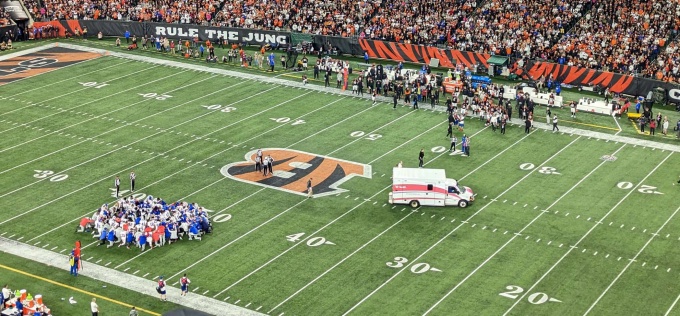
Background photo courtesy of Wikimedia Commons
Damar’s Law, a plea for preparedness
A far-reaching research project by three students in UB Law’s sports law program is up for national attention with its publication by a specialty journal of the American Bar Association.
The students—now newly graduated—participated in a practicum with Professor Helen “Nellie” Drew '88. Their research project grew out of the lifesaving response by Buffalo Bills medical staff when safety Damar Hamlin suffered sudden cardiac arrest during a Monday Night Football game in 2023. The Bills had a safety plan and executed it flawlessly, leading to the question, shouldn’t athletes at all levels enjoy the same kind of protections?
“The hope is to take the incredibly well-thought-out practices and protocols that the elite sports leagues have developed and push them out to the general public, to protect everyone’s access to safer sports,” Drew says.
Toward that end, the former students started by researching policies around automated external defibrillators (AEDs) and cardiopulmonary resuscitation. But they quickly broadened the scope of their research, looking into traumatic brain injuries and concussions, heat stroke, cold injuries and anaphylactic shock. Among other experts, they drew on the expertise of two physicians at UB’s Jacobs School of Medicine and Biomedical Sciences: Dr. John J. Leddy, a concussion specialist, and Dr. Leslie J. Bisson, a specialist in orthopedics and the team physician for the Buffalo Sabres and the Buffalo Bills.
What finally resulted was a seven-page model law, proposed legislation that would require schools, health clubs and venues to create an emergency action plan for dealing with life-threatening sports injuries and designate a safety officer responsible for implementing the plan. The proposal, which they’ve called Damar’s Law, also mandates training for emergency response and includes an indemnification clause for emergency responders.

Madeline Drechsel ’24
Published in the ABA’s Entertainment and Sports Lawyer Journal (Vol. 40, Issue 2, June 2024), their white paper argues for the necessity of the law, with the proposed law itself as an attached exhibit.
The hope, says one of the authors, Madeline Drechsel ’24, is that a full-fledged emergency response plan will become a familiar part of youth sports. “Over time, these procedures get established,” Drechsel says. “You put these emergency kits and plans in place at the level of youth sports and high school athletics, and people start to know them. Then when you get to the higher levels, it becomes expected. It’s almost like a fire drill.”

Matthew Pickard ’24
The benefit of saving a human life, of course, is priceless. But in the published paper, the authors also make economic arguments in support of Damar’s Law—noting, for example, that AEDs, which range in price from $1,200 to $3,000, are a lot less costly than funeral expenses, lawsuits and legal fees.
They framed their argument in dollars, says another author, Matthew Pickard ’24, because lawmakers always consider the cost of legislation. “It essentially comes down to money for the majority of decisions that are made,” he says. “You can show the broader benefits of a law like this, but you have to show that the cost benefit is there, too. We were trying to demonstrate that it might be a lot of work and cost up front, but in the long run it will save you money from lawsuits.”

Shelley Payne ’24
The third author, Shelley Payne ’24, was working from experience in writing about the necessity of designating a safety officer for a team. She has coached hockey at UB and in Canada at the junior level, and she has held that role of designated safety officer.
“If you have an athletic trainer, obviously that’s your person,” Payne says. “But there needs to be someone who knows: Where is the AED in this rink? Who’s calling 911 if we need to do that? In the heat of the moment, it’s so hard to make decisions. You want to take away the guesswork.”

